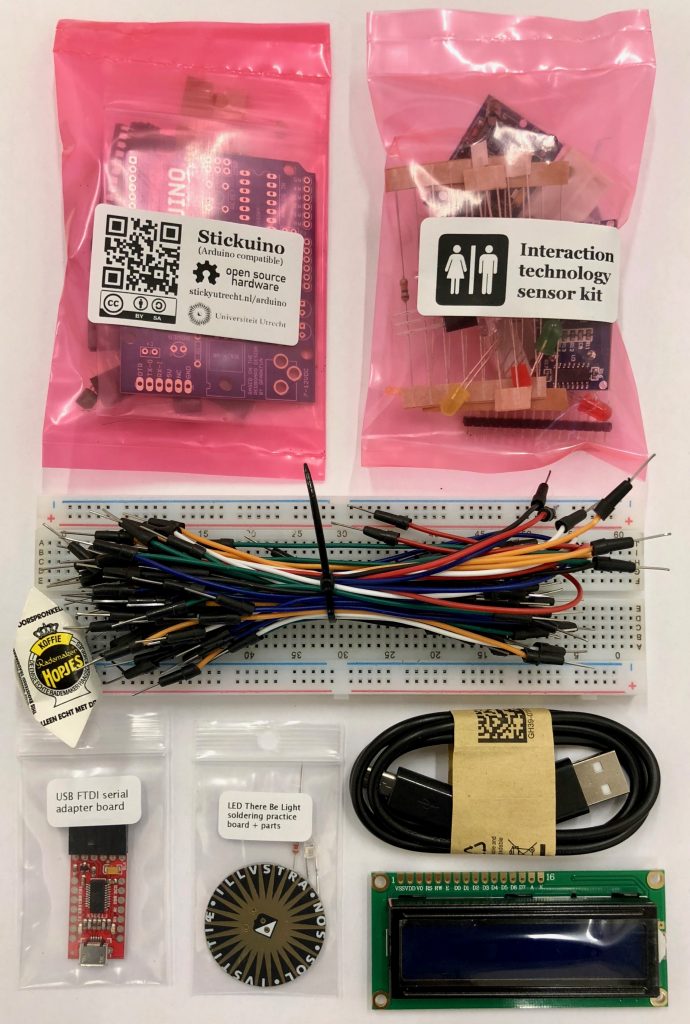Your Interaction technology kit that you acquired should contain the following. Please check the contents immediately upon reception of your kit. Should anything be missing, contact the lecturer of the embedded systems and sensors assignment. Note that you need to obtain one additional missing piece yourself.

1 * Stickuino kit. The Stickuino is the work horse of your kit for the embedded systems and sensors assignment. It’s an Arduino compatible board that contains the microcontroller. It comes as a kit and needs to be soldered during one of the soldering workshops. Be sure to check the contents of the Stickuino kit as well. Warning: do not mix the contents of this kit with the Interaction technology sensor kit (see below) or the Interaction technology IoT kit (see below) that you acquired at the same time, as they both contain similarly looking but functionally very different components!
1 * USB FTDI serial adapter board. This boards is needed to connect your Stickuino to the USB port of your computer for serial communication with and programming of the microcontroller. It is an adapter board that interfaces between USB an the TTL serial levels of the Stickuino and it is very similar to other USB serial adapter boards (1, 2).
1 * Micro USB cable. You’re probably familiar with those. However, you can’t be without ‘m and that’s why one is included with the USB FTDI serial adapter board.
1 * Breadboard, full size. A breadboard is a very useful construction base for prototyping of electronics. It offers a solderless and therefore reusable way to build and experiment with electronic circuits. You’ll be building most of your circuits on this breadboard.
1 * Set jumper wires, variable length, approx. 65 pieces. These jumper wires go together with your breadboard. They are used to interconnect components that are not already interconnected through the breadboard.
1 * Interaction technology sensor kit. This kit contains the remainder of the electronic components that you’ll need to complete the embedded systems and sensors assignment. Although named a sensor kit, it actually also contains a number of actuators, as well as some other supportive hardware. Check its contents and, once more, if you’re missing something, please contact the lecturer a.s.a.p. Warning: do not mix the contents of this kit with the Stickuino kit (see above) or the Interaction technology IoT kit (see below). Sensors and actuators and their supportive hardware are described in more detail on the sensors and actuators page. The Interaction technology sensor kit should contain the following.
1 * LCD display, 2×16 with backlight
1 * Ultrasonic distance sensor, HC-SR04
1 * Motion sensor, PIR, HC-SR501
1 * Light sensor, LDR, GL5516
1 * Temperature sensor, DS18B20 compatible
1 * Magnetic contact sensor, including magnet
3 * Push button
1 * LED, 5mm, red
1 * LED, 5mm, green
1 * LED, 5mm, yellow
1 * RGB LED, 5mm, common cathode
1 * Mosfet, IRLZ34N
1 * Diode, 1N4007
8 * Resistor, 220 Ohm
8 * Resistor, 10k Ohm
2 * Resistor, 2.2k Ohm
1 * Variable resistor, 10k Ohm
1 * Header strip for LCD, male, straight, 16 pins
1 * LED There Be Light soldering practice board + parts. No picture, but you’ll recognize it when you see it ;-). This board allows you to try out a few solder joints before you start working on your Stickuino. For this purpose, the bag containing the LED There Be Light board also includes a mini 220 Ohm resistor and a fast-auto-changing transparent 3mm RGB led.
1 * Instant caffeine. Electronic devices run on magic smoke. Once the smoke is out, the device stops working. Hackers work on caffeine. Once the caffeine runs out, the hacker stops working.
1 * Interaction technology IoT kit. This kit contains the additional electronic components that you’ll need to complete the Internet of Things (IoT) assignment. Check its contents and, once more, if you’re missing something, please contact the lecturer a.s.a.p. Warning: do not mix the contents of this kit with the Stickuino kit (see above) or the Interaction technology sensor kit (see above). The hardware components in this kit will be described in more detail when the IoT assignment is published. After checking its contents you may put the Interaction technology IoT kit aside until you start working on the second assignment. The Interaction technology IoT kit should contain the following.
1 * NodeMCU ESP8266 development board, V1.0
1 * Soil moisture sensor, including wires and LM393 comparator board
1 * Pressure and temperature sensor, BMP280, including header strip, male, straight, 6 pins
1 * Accelerometer and gyroscope, 3-axis, MPU6050, including header strips, male, 8 pins
1 * OLED display, 0.96″, 128×64
1 * Micro servo, including arms and screws
1 * Analog multiplexer SMD soldering exercise, containing:
— 1 * Analog multiplexer printed circuit board
— 1 * Analog multiplexer IC, 74HC4051, SMD (IC1)
— 1 * Capacitor, 0.1uF, SMD, 0805 (C1)
— 1 * LED, red, SMD, 0805 (D1)
— 1 * Resistor, 1k Ohm, SMD, 0805 (R1)
— 2 * Resistor, 10k Ohm, SMD, 0805 (R2, R3)
— 1 * Header strip, male, straight, 8 pins
(In years before 2022/2023 the Interaction technology IoT kit included a BME280 instead of a BMP280, which added a humidity sensor to the mix. Unfortunately, due to component shortages and price inflation in recent years, this is no longer an option. However, this won’t make a big difference, assignment-wise.)
Note: the Interaction technology IoT kit is an add-on. To complete the IoT assignment some of the components of the Interaction technology sensor kit are needed as well. You’ll also need to reuse generic components such as your breadboard, jumper wires and micro USB cable for the IoT assignment.